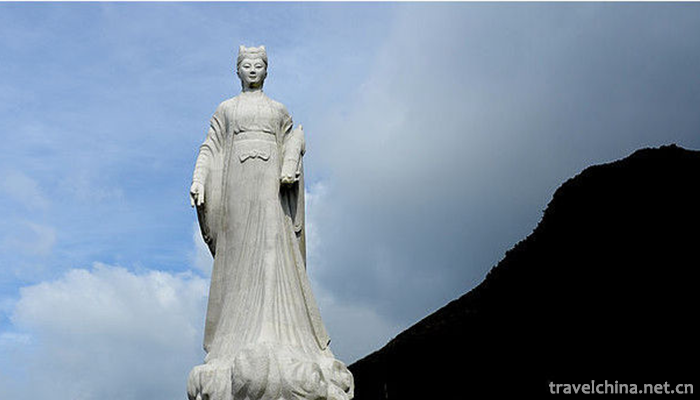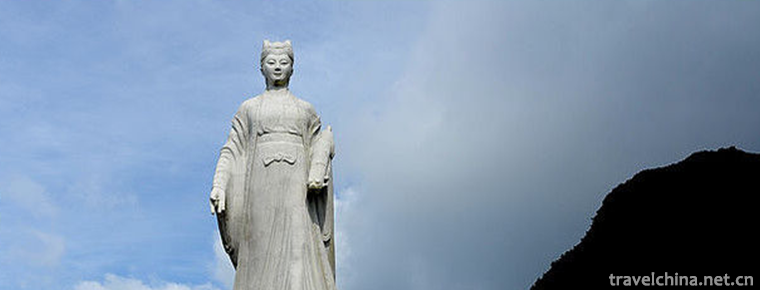Ma Xian Xing custom
Ma Xian Xing custom
The belief in Ma Xian is a traditional folk custom inherited from generation to generation by the people of Fujian and Zhejiang. Ma Xian, also known as Ma Xiaoxian, is a goddess worshipped in northeastern Fujian and southeastern Zhejiang. For decades, mother-in-law and daughter-in-law depended on each other, tolerated humiliation and burdened her, and served her aunt diligently until she died. His filial piety touched the heavens, passed on as a good story, and was sacrificed to God after his death. Tang Suzong was named "Mrs. Mars Protector of the Nation" when he was emperor. He was also known as the three goddesses of Fujian and Zhejiang together with Mazu and Chen Jinggu.
Folklore introduction
Ma Xian Folklore is a kind of folk custom which was approved by the State Council in 2014 and listed in the fourth batch of national intangible cultural heritage list.
The belief in Ma Xian is a traditional folk custom inherited from generation to generation by the people of Fujian and Zhejiang. Ma Xian, also known as Ma Xiaoxian, is a goddess worshipped in northeastern Fujian and southeastern Zhejiang. For decades, mother-in-law and daughter-in-law depended on each other, tolerated humiliation and burdened her, and served her aunt diligently until she died. His filial piety touched the heavens, passed on as a good story, and was sacrificed to God after his death. Tang Suzong was named "Mrs. Mars Protector of the Nation" when he was emperor. He was also known as the three goddesses of Fujian and Zhejiang together with Mazu and Chen Jinggu. Ma Xianxiao's filial piety is also regarded as a model of filial piety by the upper class. Famous historical figures such as Li Yangbing, Liu Bowen and Feng Menglong all wrote articles to praise it. Ma Xian belief was introduced into Zherong in the Song and Yuan Dynasties. It was not only regarded as a model of filial piety, but also became the spiritual sustenance of the people in eliminating disease, eliminating disaster and resisting disaster. Every year, "Yingxian" Temple Ceremony is held. Mothers or mothers-in-law lead their daughters and daughters-in-law to the temple to offer sacrifices. They tell the story of Ma Xian's filial piety and pass on the spirit of filial piety, thus forming a complete set of Ma Xian's beliefs and customs. During the Ming and Qing Dynasties, Ma Xian's beliefs and customs were widely spread and deeply rooted in Funing Prefecture (now Eastern Fujian). Zherong is the center of Maxian belief. The most typical and influential activities of Maxian belief are Zherong. Its influence extends to Fujian, Zhejiang, Jiangxi, Guangdong, Taiwan and Southeast Asia, with more than 20 million followers. Zherong Dongshi Mountain, known as "Xianshan", is a sacred mountain for worshippers of Ma Xian on the border between Fujian and Zhejiang. It is said that the Lingyan Cave on the mountain is Ma Xian's temple and its central place is Ma Xian Temple in Chengguan Xianyu. The thousand-year inheritance of Ma Xian's beliefs and customs has left many cultural relics and attractions, including Lingyan Cave in Song Dynasty, Ma Xian Temple in Yuan Dynasty, Dongshishan Cliff Carvings in Ming Dynasty, and plaques in Ming and Qing Dynasty. There are Baizhangyan, cactus footprints, cactus stream, cactus spring and cactus island.
Forms of expression
The main manifestation of Ma Xian's religion and custom is to hold a grand party on the seventh day of the seventh month of the lunar calendar every year. Its activities consist of the following links: receiving immortals, starting from the Lingyan Cave; offering sacrifices, ritual ceremonies, the central venue in the Maxian Temple of Chengguan Xianyu; traveling in the thirteenth border in order; sending immortals, and sending Ma Xiangyu back to the Lingyan Cave solemnly. At the same time, folk art exhibitions are held, mainly including: Taige, opera, puppet, lantern art, acrobatics, dance, lantern riddles and so on. During the celestial reception, the mother took her children and mother-in-law took her daughter-in-law to worship Ma Xian. Ma Xian was worshipped as a model of filial piety, and gradually evolved into a local god of protection for people to dispel illness, alleviate disaster and protect peace.
Ma Xian's faith and custom activities are to pray for a peaceful country, a prosperous life, harmonious friendship in the thirteenth realm, the integration of traditional morality and filial piety with modern civilization, and the performance of folk traditional art. Ma Xian's religion advocates serving mothers, filial piety, good neighborhood and benefiting the world, which has moral education value. It has important practical enlightenment value for building a harmonious society through the friendship of thirteen borders. During the Ma Xian Temple Festival, mothers and daughters, mothers-in-law and daughters-in-law worshiped Ma Xian, and spread the virtue of Ma Xian's filial piety to their parents-in-law, so as to spread the traditional filial piety culture from generation to generation, promote family harmony and contribute to the construction of a happy family and a civilized society. In the ceremony of "welcoming immortals", the followers run through the whole process with the concept of filial piety, harmony, health and peace, especially advocating and disseminating the filial piety culture of harmony between mother-in-law and daughter-in-law, neighborhood harmony, diligence and thrift, which has the deep-seated characteristics of social morality and is worthy of imitation and implementation in the contemporary era. Influenced by the lack of traditional filial piety education in the contemporary era, the concepts of filial piety, harmony, health and peace advocated by Ma Xian's beliefs and customs not only conform to the traditional virtues of the Chinese nation, but also conform to the moral education of today's society. They have important practical significance and mainstream value in promoting traditional culture and building a harmonious society. Horse custom belief activities provide a carrier for the inheritance of Zherong folk culture and art. Many folk arts, such as string puppet show, bag show, floor show, elevation Pavilion decoration, lighting paper-cut and other skills, are inherited and consolidated in the ceremony activities, and create opportunities for artists'artistic creation and development; Horse custom belief activities, for the government to understand and protect the intangible heritage. Conservation provides complete information, which still has important enlightenment and reference value for the construction of contemporary modern culture.


-
1.The longji yao and zhuang ethnic terraceTime 2018-10-12
-
2.Wa Palace Scenic Area Handan City
Wa Palace, located in Zhonghuangshan Mountain, Shexian County, Handan City, Hebei Province, covers an area of 5 square kilometers.
Time 2018-11-24 -
3.Historic Architectural Complex in Heaven and Earth
Historic buildings in Tiandi, World Cultural Heritage, National Key Cultural Relics Protection Units and National AAAAA Tourist Scenic Spots are located in the hinterland and surrounding
Time 2019-02-21 -
4.Wuhou Tomb Scenic Area
The Tomb of Marquis Wu is the tomb of Zhuge Liang, a famous statesman and militarist in the Three Kingdoms Period. It is located at the foot of the ancient battlefield of Dingjunshan
Time 2019-02-24 -
5.Bai opera
After 1949, on the basis of blowing tunes, Bai folk opera "Dabenqu" tunes were further enriched and improved, renamed "Baiju". The Lyric forms are basically sung in Bai language an
Time 2019-04-03 -
6.Carpet Weaving Techniques
Uygur carpet is a handicraft with a long history and tradition. It integrates painting, sculpture, knitting, embroidery, printing and dyeing. Characteristic
Time 2019-04-26 -
7.Lei opera
Lei Opera, formerly known as the Grand Opera Class, was once known as "Leizhou Opera" because of its early tune of Leizhou songs. It is one of the national intangible cultural heritage of Le
Time 2019-05-11 -
8.Forging Skill of Longquan Sword
Longquan sword forging technology, the traditional arts and crafts of Longquan County, Zhejiang Province, is one of the national intangible cultural heritage.
Time 2019-05-14 -
9.Nanjing White Bureau
Nanjing Baiju is an ancient type of music in Nanjing area. The "Nanjing tune" in the Yuanqu brand is the original tune of Baiju's ancient tune. It has a history of more than 700 years. It wa
Time 2019-06-07 -
10.Wudang Martial Arts
At the end of Yuan Dynasty and the beginning of Ming Dynasty, Zhang Sanfeng, a Taoist of Wudang School, established Wudang School and was respected as the founder of Wudang Wushu.
Time 2019-06-30 -
11.Cognitive Method of Life and Disease in Traditional Chinese Medicine
Cognitive method of life and disease of traditional Chinese medicine, one of traditional Chinese medicine, is declared by the Chinese Academy of Traditional Chinese Medicine and one of the national in
Time 2019-08-03 -
12.Yibin landform
The topography of Yibin City is high in the southwest and low in the northeast. In the west, there are yuxu of Liangshan and Xiaoliangshan, and Laojun Mountain is the highest point of Wuzhi Mountain in Pingshan County with an altitude of 2008.7 meters;
Time 2020-12-18